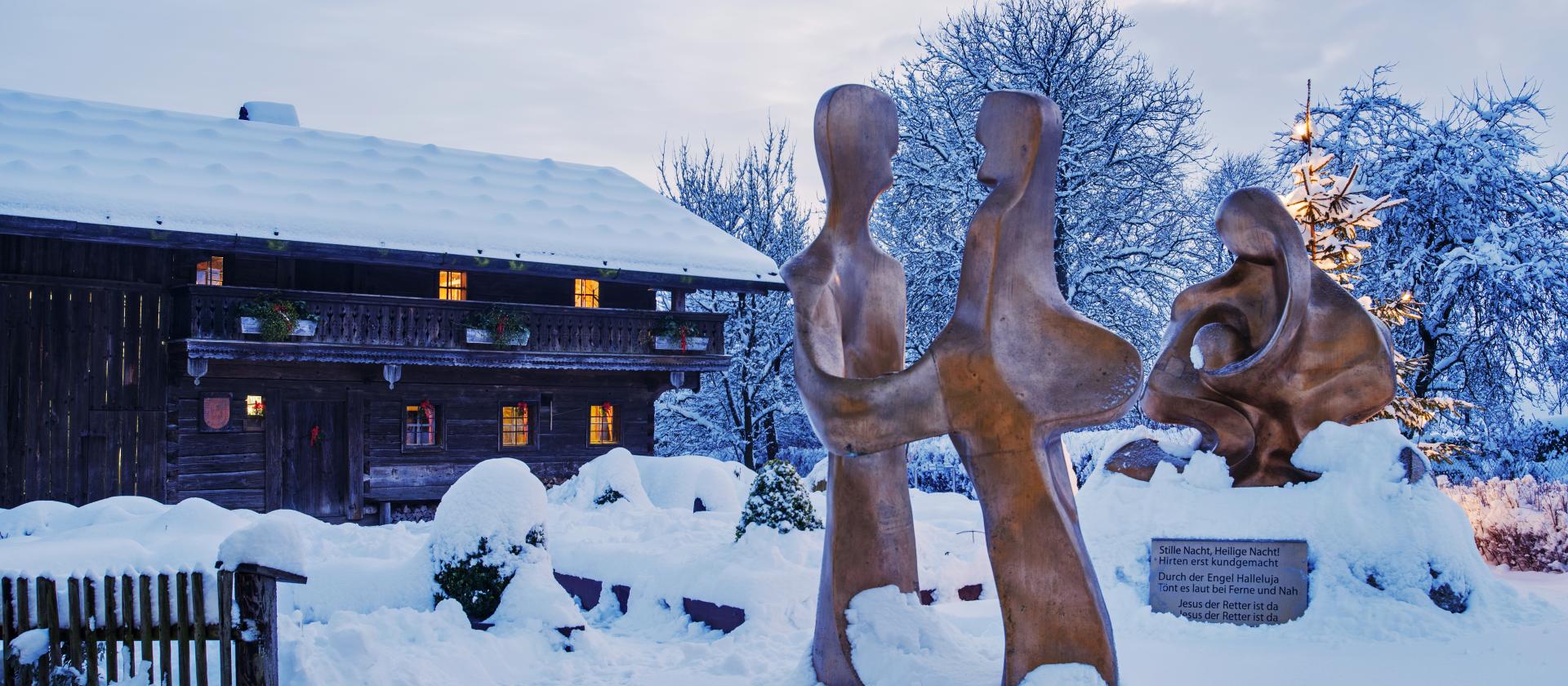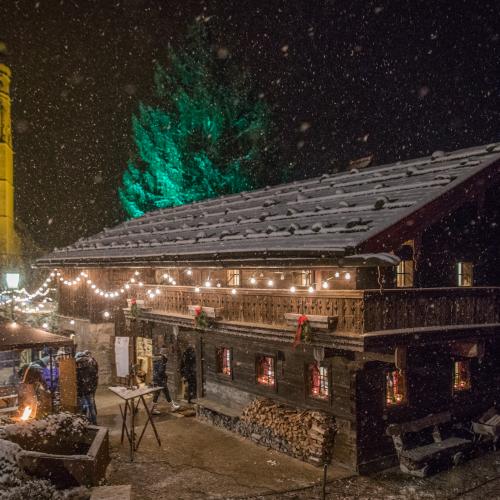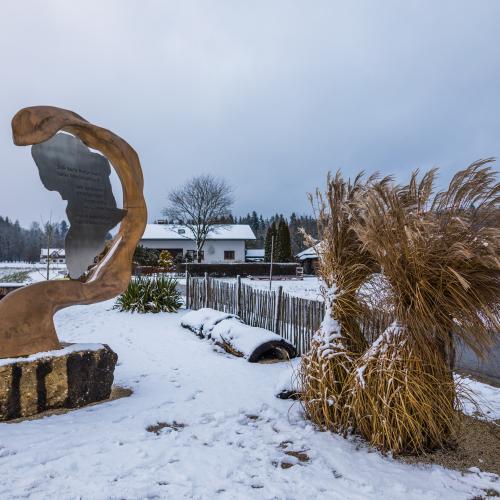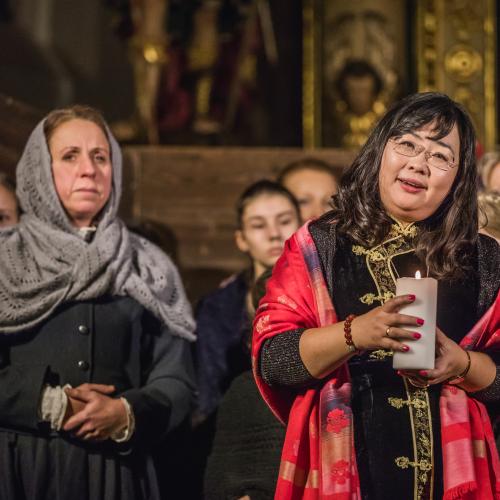Hochburg-Ach
Franz Xaver Gruber’s birthplaceIt was the year 1787 when Conrad Xaver Gruber was born on 25 November as the fifth child of a family of weavers at Unterweitzberg 9 near Hochburg-Ach. Not far from the area, the Salzach river flows northbound. Back in the day, it was a crucial transport route for the precious salt of Salzburg’s archbishops and shortly thereafter also a border river. For in 1779, Bavaria had to hand the Innviertel region over to Austria as a result of the War of the Bavarian Succession. Until then, Hochburg had been part of Burghausen.
Franz Xaver Gruber’s birthplace
Little Franz Xaver Gruber — he took on the name of his godfather — grew up during the uncertain days of the Napoleonic Wars. As a result of new demarcations, entities and borders which had proved useful for centuries were torn apart. Napoleon quite literally stood at the doorsteps and was set to approach even closer. In 1800, a French army corps moved into Upper Austria and stayed in the region for a whole year. Only in March 1801, the occupants withdrew again. Hochburg’s death register counts many deaths resulting from abuse and assault. In 1805/1806, Austria and Bavaria were overwhelmed by French troops all over again. Burghausen suffered strongly during its time under French occupation. When Napoleon himself came to Burghausen with around 100,000 soldiers in 1809 and spent several days here, Franz Xaver Gruber had already completed his training and took up his first teaching position in Arnsdorf.
- (c) Stille Nacht – Oberösterreich Tourismus GmbH, Hochburg-Ach, Franz-Xaver-Gruber-Memorial House
- (c) Stille Nacht – Oberösterreich Tourismus GmbH, Franz Xaver Gruber Peace Path, Hochburg-Ach
- (c) Stille Nacht – Oberösterreich Tourismus GmbH, Hochburg-Ach historical pageant
New paths for Franz Xaver Gruber
Gruber’s grandparents Josef and Anna Gruber were small farmers and linen weavers. Weaving was an important additional source of income at the time. Nevertheless, the parents’ sparse earnings were barely enough to cover the costs of raising a family. And perhaps it thus came as no surprise that linen weaver Josef Gruber was intolerant of experimentations. His son Franz Xaver was to — just like himself — perform the honourable duty of the linen weaver. His teacher Andreas Peterlechner and the pastor Simon Dobler, on the other hand, quickly caught wind of the boy’s musical abilities: Peterlechner in particular supported the boy wherever possible. Finally, even the strict father could no longer ignore his son’s extraordinary talents and gave him permission to attend organ lessons with the well-known choirmaster Georg Hartdobler in Burghausen, eight kilometres away. Hartdobler was so impressed by the 18-year-old, that he provided him with board and accommodation and did not charge him for lessons. After only three months of teaching, Franz Xaver Gruber was capable of playing the basso continuo on the organ. He also played the violin, continued his musical education and began composing his own songs.
After Franz Xaver Gruber received permission from his father to pursue teacher training, he completed his examinations in 1806 and then returned to his place of birth. He completed the mandatory year of work experience as a school assistant with his supporter and teacher Andreas Peterlechner in Hochburg.
- Several spots which were crucial during Franz Xaver Gruber’s life are located on the outskirts of Hochburg: the Maria Himmelfahrt Parish Church, where the historical performance “The Search for the Silent Night” is performed each year on the third Advent weekend, as well as the Stiftsgasthof guest house, where Gruber produced a four-part wedding song to honour his sponsor. Additional locations include the school named after Gruber, as well as the residences of the teacher Peterlechner and the Gruber family, which are no longer present in their original states.
- To replace Franz Xaver Gruber’s birth house in the Unterweitzberg district, which was demolished in 1927, a nearly identical, more than 200-year-old wooden house was transported to Hochburg from the neighbouring municipality of Gilgenberg and faithfully reconstructed. The museum contained within the Gruber Memorial House (“Grubahäusl”) documents what life and work were like around 1800. The house contains various objects from the family: The most precious piece is the loom with which Franz Xaver Gruber learned the weaving craft. Curator Hans Schwarzmayr and his team provide guided tours for those who register in advance.
- In 2012, a two-kilometre-long Franz Xaver Gruber Peace Path was created which explains and illuminates many important stations in the life of the great composer, as well as the truly boundless significance of the globally beloved Silent Night song. Starting and end points are the Gruber Memorial Building: From here, you can take an approximately one-hour long “world trip” across all continents. The Tyrolean artist Hubert J. Flörl created the sculptures. The idea is that the song’s message of peace is carried to the various continents of the world via angel wings. A quote about peace is presented at each of the stations. The spaces on which the peace path’s five stations have been erected have been provided by Hochburg’s private property owners. And they assumed the maintenance of the gorgeous patches at the same time.



